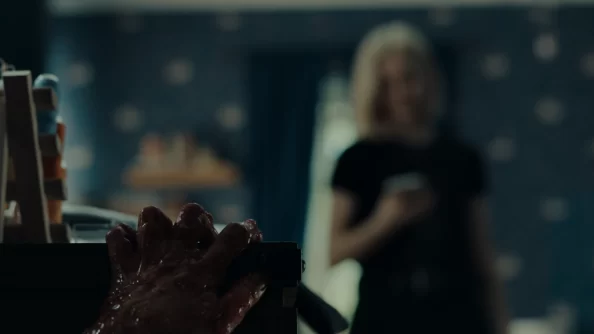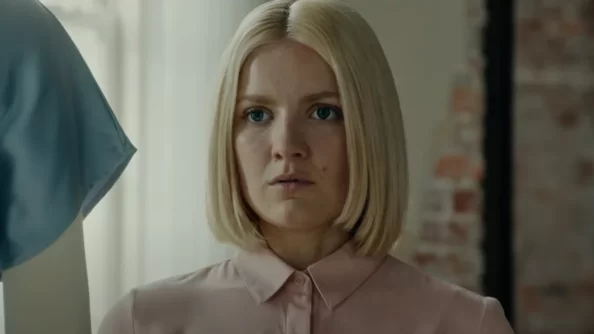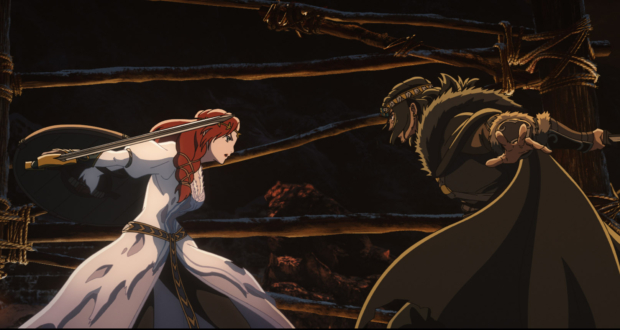In the dark, disturbing realm of body horror, Anna Zlokovic‘s Appendage plunges audiences into a nightmarish journey through the psyche of its protagonist, Hannah, played with palpable vulnerability by Hadley Robinson. The film serves as a stark reminder that beneath the surface of our seemingly ordinary lives, deep-seated insecurities and self-doubt can fester and manifest in unimaginable ways. While Appendage delves into the unsettling world of body horror with a unique premise, it falls short of reaching its full potential, ultimately leaving viewers with a mix of fascination and frustration. Read on for my Appendage review.
The Good Parts Of The Appendage Review:

The narrative centers on Hannah, a young fashion designer whose exterior belies the turmoil within. Robinson’s performance is a standout, capturing the essence of Hannah’s internal struggle with nuance and authenticity. The character’s descent into madness is both captivating and harrowing to watch, as her crippling self-doubt manifests physically in the form of The Appendage, a grotesque growth that becomes a metaphorical representation of her anxieties.
The body horror elements in Appendage are undeniably grotesque and well-executed. The practical effects are commendable, showcasing the filmmakers’ dedication to crafting a visually disturbing experience. The transformation scenes are particularly visceral, leaving a lasting impression on the audience. Zlokovic masterfully uses body horror to evoke a visceral reaction, making viewers squirm in their seats as they witness Hannah’s descent into madness.
The supporting cast, including Emily Hampshire as Claudia, Deborah Rennard as Stacy, Brandon Mychal Smith as Kaelin, and Kausar Mohammed as Esther, delivers solid performances, grounding the film in reality despite its surreal premise. The interactions between these characters add depth to the narrative, offering glimpses into the various ways people cope with their insecurities. However, the supporting characters lack sufficient development, preventing them from becoming fully fleshed-out individuals. As a result, their stories feel underexplored, leaving the audience wanting more insight into their experiences with The Appendage.
The body horror elements in Appendage are undeniably grotesque and well-executed.
The film’s cinematography, helmed by Powell Robinson, is a visual feast for horror enthusiasts. The use of shadow and light creates a haunting atmosphere, amplifying the sense of dread that permeates the story. The claustrophobic and unsettling imagery heightens the tension, enhancing the overall viewing experience. Additionally, the film’s sound design and score contribute to the eerie ambiance, effectively immersing the audience in Hannah’s deteriorating world.
One of Appendage‘s strengths lies in its ability to elicit empathy for its protagonist. Despite the film’s shortcomings, Hannah’s journey is undeniably poignant, resonating with anyone who has experienced self-doubt or struggled with their self-esteem. Robinson’s raw and vulnerable portrayal makes Hannah a relatable and sympathetic character, eliciting genuine emotions from the audience.
The Bad Within This Appendage Review

However, where Appendage stumbles is in its exploration of the psychological aspects of body horror. The film hints at deeper themes, such as the impact of societal pressures and the fragility of self-esteem, but fails to delve into these issues with the depth they deserve. Hannah’s anxieties, while palpable, are never fully dissected, leaving the audience craving a more profound understanding of her inner demons. The film skims the surface of these complex issues without delving into the underlying psychological intricacies, leaving viewers yearning for a more profound and thought-provoking exploration.
In addition, it’s undeniable how much inspiration this film took from 2021’s Malignant, a film that does a considerably better job at exploring the body horror themes and ideas, as well as its approach to being unabashedly campy. Don’t get me wrong, if we get tons of movies that feel similar to Malignant from here on out – that’s great. But, when the inspiration is this obvious, it’s a bit hard to look past. It almost feels like a spin-off to that film at times.
Overall Impression:
Appendage is a visually striking and emotionally charged body horror film that captivates with its grotesque imagery and strong central performance. While it excels in creating a disturbing atmosphere and evoking visceral reactions, the film falls short of fully exploring the psychological complexities of its characters and themes. The lack of depth in character development and thematic exploration leaves the audience with a sense of unfulfilled potential. Despite its flaws, Appendage manages to leave a lasting impression, sparking contemplation about the demons we hide beneath our skin and the importance of confronting our inner fears before they consume us.
What did you think of Appendage? Let me know in the comments below.
Appendage Review: A Twisted Tale of Body Horror and Self-Doubt
-
Acting - 8/10
8/10
-
Cinematography/Visual Effects - 7/10
7/10
-
Plot/Screenplay - 6/10
6/10
-
Setting/Theme - 6.5/10
6.5/10
-
Watchability - 8/10
8/10
-
Rewatchability - 6.5/10
6.5/10















